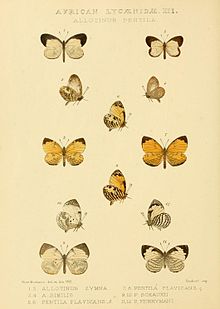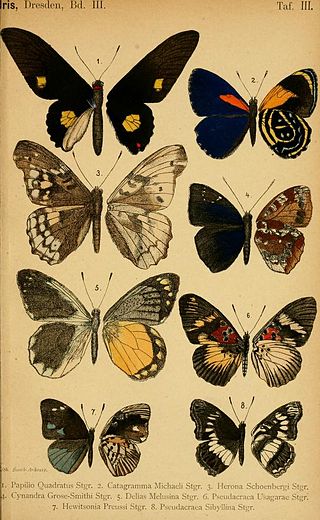
Hewitsonia is a genus of butterflies in the family Lycaenidae. The species of this genus are endemic to the Afrotropical realm.
Stempfferia similis is a butterfly in the family Lycaenidae. It is found in Cameroon, the Republic of the Congo, the Central African Republic and Gabon.
Hewitsonia amieti is a butterfly in the family Lycaenidae. It is found in Cameroon.
Hewitsonia bitjeana is a butterfly in the family Lycaenidae. It is found in south-eastern Nigeria, southern Cameroon and possibly Gabon and the Republic of the Congo.
Hewitsonia beryllina, the green tiger blue, is a butterfly in the family Lycaenidae. It is found in Nigeria, western Cameroon and the Republic of the Congo. The habitat consists of forests.

Hewitsonia boisduvalii, the large tiger blue, is a butterfly in the family Lycaenidae. It is found in Guinea, Liberia, Ivory Coast, Ghana, Nigeria, Cameroon, Gabon, the Republic of the Congo and the Central African Republic. The habitat consists of primary and secondary forests with a closed canopy.
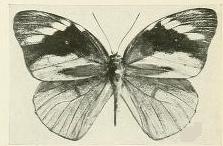
Hewitsonia congoensis is a butterfly in the family Lycaenidae. It is found in Cameroon and the Democratic Republic of the Congo.
Hewitsonia danane, the Stempffer's tiger blue, is a butterfly in the family Lycaenidae. It is found in western Ivory Coast, southern Nigeria and central and western Cameroon.

Hewitsonia inexpectata, the unexpected tiger blue, is a butterfly in the family Lycaenidae. It is found in Sierra Leone, Liberia, Ivory Coast, Ghana, Togo, Nigeria, Cameroon, the Republic of the Congo, the Central African Republic, the Democratic Republic of the Congo, Uganda, western Kenya and north-western Tanzania. The habitat consists of forests.
Hewitsonia intermedia is a butterfly in the family Lycaenidae. It is found in the Democratic Republic of the Congo, Uganda and north-western Tanzania. The habitat consists of forests.
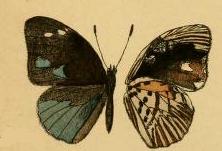
Hewitsonia kirbyi, the Kirby's tiger blue, is a butterfly in the family Lycaenidae. It is found in Nigeria, Cameroon, Gabon, the Republic of the Congo, Angola, the Democratic Republic of the Congo and Zambia. The habitat consists of forests.
Hewitsonia magdalenae is a butterfly in the family Lycaenidae. It is found in the Democratic Republic of the Congo.
Hewitsonia occidentalis, the western tiger blue, is a butterfly in the family Lycaenidae. It is found in Guinea, Ivory Coast, Ghana and western Nigeria. The habitat consists of forests.
Hewitsonia prouvosti is a butterfly in the family Lycaenidae. It is found in central Cameroon.
Hewitsonia ugandae is a butterfly in the family Lycaenidae. It is found in Cameroon, Gabon, the Democratic Republic of the Congo and western Uganda.
Hewitsonia kuehnei is a butterfly in the family Lycaenidae. It is found in Kenya, Tanzania and Uganda.

Liptena similis, the similar liptena, is a butterfly in the family Lycaenidae. It is found in Guinea, Sierra Leone, Liberia, Ivory Coast, Ghana, Nigeria, Cameroon and Gabon.
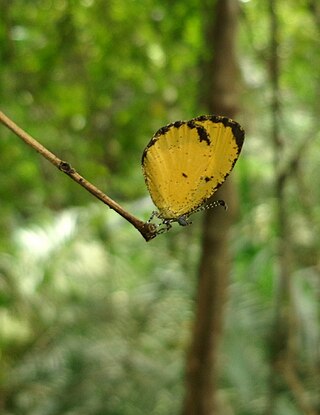
Citrinophila similis, the similar yellow, is a butterfly in the family Lycaenidae. It is found in Guinea, Sierra Leone, Ivory Coast, Ghana, southern Nigeria, and Cameroon. Its habitat consists of forests.

Arhopala similis is a species of butterfly belonging to the lycaenid family described by Hamilton Herbert Druce in 1895. It is found in Southeast Asia . In this species, contrary to Arhopala catori, all the 4 spots in the costal area of the hindwing beneath are distinctly developed and in distinct light rings. In the forewing the postmedian transverse band is entirely absent, whilst in the hindwing it is broken up into hardly contiguous rings. Above the male is still more broadly margined with black than A. catori, particularly in the apex; the female is very similar to it, lighter blue.
